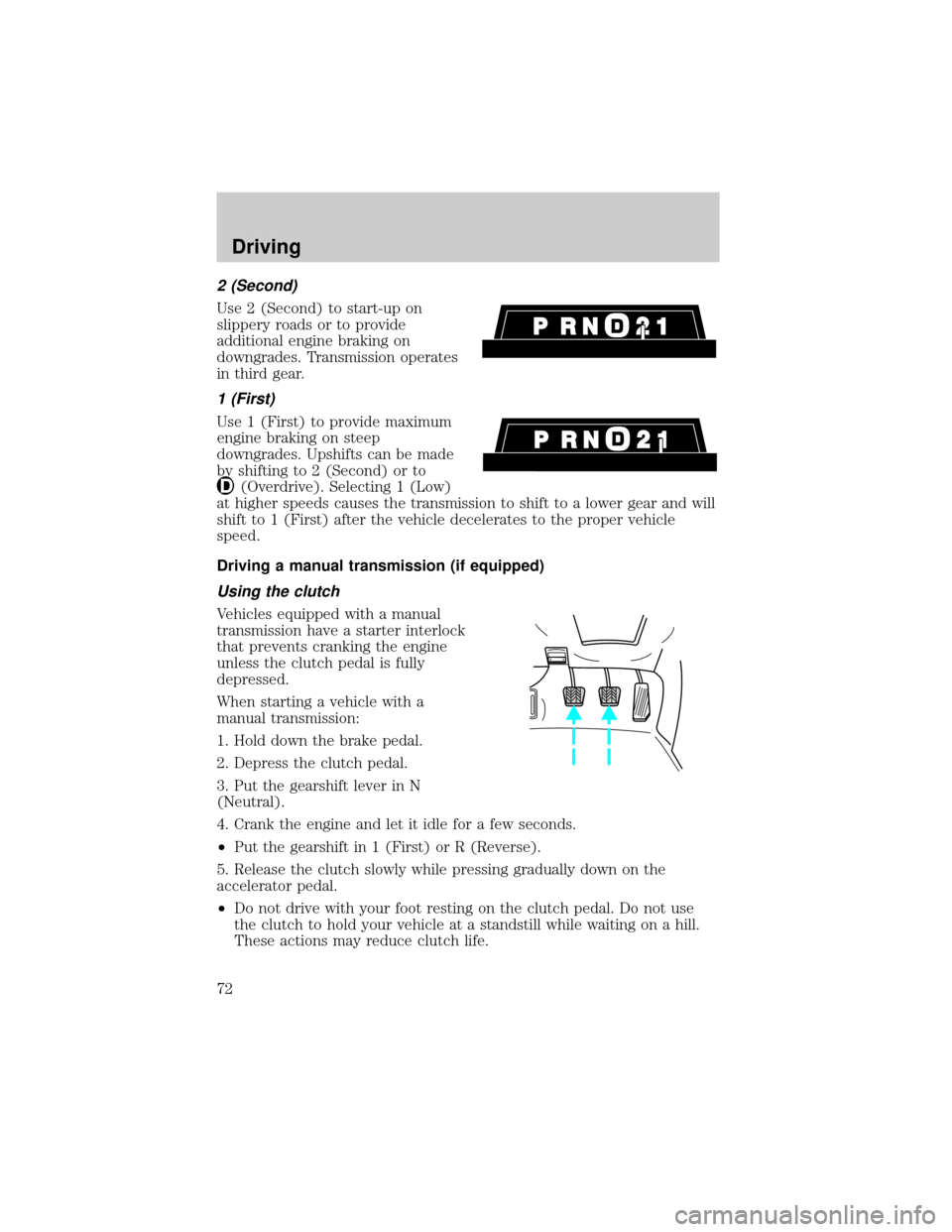Page 60 of 160
2. Make sure the headlamps and vehicle accessories are off.
If starting a vehicle with an automatic transmission:
²Make sure the parking brake is
set.
²Make sure the gearshift is in P (Park).
If starting a vehicle with a manual transmission:
²Make sure the parking brake is set.
²Push the clutch pedal to the
floor.
3. Turn the key to 4 (ON) without
turning the key to 5 (START).
1
2
34
5
Starting
60
Page 67 of 160

Always set the parking brake fully and make sure that the
gearshift is securely latched in P (Park) (automatic
transmission) or in 1 (First) (manual transmission).
The parking brake is not designed to stop a moving vehicle. However, if
the normal brakes fail, the parking brake can be used to stop your
vehicle in an emergency. Since the parking brake applies only the rear
brakes, the vehicle's stopping distance will be adversely affected.
Pull the release lever to release the
brake. Driving with the parking
brake on will cause the brakes to
wear out quickly and reduce fuel
economy.
TRANSMISSION OPERATION
Automatic transmission operation
Brake-shift interlock
This vehicle is equipped with a brake-shift interlock feature that prevents
the gearshift from being moved from P (Park) unless the brake pedal is
depressed.
If you cannot move the gearshift out of P (Park) with the brake pedal
depressed:
1. Apply the parking brake, turn ignition key to LOCK, then remove the
key.
2. Insert the key and turn it to OFF. Apply the brake pedal and shift to N
(Neutral).
3. Start the vehicle.
If it is necessary to use the above procedure to move the gearshift, it is
possible that a fuse has blown. Refer toFuses and relaysin the
Roadside emergencieschapter.
Driving
67
Page 72 of 160

2 (Second)
Use 2 (Second) to start-up on
slippery roads or to provide
additional engine braking on
downgrades. Transmission operates
in third gear.
1 (First)
Use 1 (First) to provide maximum
engine braking on steep
downgrades. Upshifts can be made
by shifting to 2 (Second) or to
(Overdrive). Selecting 1 (Low)
at higher speeds causes the transmission to shift to a lower gear and will
shift to 1 (First) after the vehicle decelerates to the proper vehicle
speed.
Driving a manual transmission (if equipped)
Using the clutch
Vehicles equipped with a manual
transmission have a starter interlock
that prevents cranking the engine
unless the clutch pedal is fully
depressed.
When starting a vehicle with a
manual transmission:
1. Hold down the brake pedal.
2. Depress the clutch pedal.
3. Put the gearshift lever in N
(Neutral).
4. Crank the engine and let it idle for a few seconds.
²Put the gearshift in 1 (First) or R (Reverse).
5. Release the clutch slowly while pressing gradually down on the
accelerator pedal.
²Do not drive with your foot resting on the clutch pedal. Do not use
the clutch to hold your vehicle at a standstill while waiting on a hill.
These actions may reduce clutch life.
Driving
72
Page 76 of 160
Shifting from 2WD (2WD high) to 4X4 HIGH (4WD High)
Move the 4WD control to the 4X4
HIGH.
At temperatures below 0ÉC (32ÉF),
shifts from 2WD to 4X4 HIGH
should not be performed above
72 km/h (45 mph).
²Do not shift into 4X4 HIGH with
the rear wheels slipping.
Shifting from 4X4 HIGH (4WD high) to 2WD (2WD high)
Move the 4WD control to 2WD at
any forward speed. Youdo notneed
to put the gearshift in R (Reverse)
to disengage your front hubs.
Shifting between 4X4 HIGH (4WD high) and 4X4 LOW (4WD low)
1. Bring the vehicle to a stop.
2. Depress the brake.
3. Place the gearshift in N (Neutral) (automatic transmission) or depress
the clutch (manual transmission).
4. Move the 4WD control to the 4X4
HIGH or 4X4 LOW position.
4X4
HIGH
2WD4X4
LOW
4X4
HIGH
2WD4X4
LOW
2WD4X4
LOW4X4
HIGH
Driving
76
Page 82 of 160

Trailer towing table (4x2 manual transmission)
Engine Rear
axle
ratioMaximum
GCWR-kg
(lbs.)Maximum
trailer
weight-kg (lbs.)
(0-maximum)Maximum frontal
area of trailer-m
2
(ft2)
Regular Cab 4x2
2.5L 3.45 Not recommended for trailer towing
2.5L 3.73 2 177
(4 800)0-717
(0-1 580)Equal to frontal
area of base vehicle
3.0L 3.45 2 267
(5 000)0-789
(0-1 740)Equal to frontal
area of base vehicle
3.0L 3.73 2 721
(6 000)0-1 225
(0-2 700)4.64 (50)
4.0L 3.08 2 267
(5 000)0-753
(0-1 660)Equal to frontal
area of base vehicle
4.0L 3.55 3 175 (7 000) 0-1 651 (0-3 640) 4.64 (50)
Regular Cab 4x2 (Splash or Special Suspension)
2.5L 3.73 2 177
(4 800)0-680
(0-1 500)Equal to frontal
area of base vehicle
3.0L 3.73 2 449
(5 400)0-907
(0-2 000)*Equal to frontal
area of base vehicle
4.0L 3.08 2 267
(5 000)0-717
(0-1 580)Equal to frontal
area of base vehicle
4.0L 3.55 2 495
(5 500)0-907
(0-2 000)*Equal to frontal
area of base vehicle
SuperCab 4x2
2.5L 3.73 2 177
(4 800)0-626
(0-1 380)Equal to frontal
area of base vehicle
3.0L 3.45 2 267
(5 000)0-698
(0-1 540)Equal to frontal
area of base vehicle
3.0L 3.73 2 271 (6 000) 0-1 133 (0-2 500) 4.64 (50)
4.0L 3.08 2 267
(5 000)0-635
(0-1 400)Equal to frontal
area of base vehicle
4.0L 3.55 3 175 (7 000) 0-1 542 (0-3 400) 4.64 (50)
Driving
82
Page 83 of 160

Trailer towing table (4x2 manual transmission)
SuperCab 4x2 (Splash or Special Suspension)
3.0L 3.73 2 540
(5 600)0-907
(0-2 000)*Equal to frontal
area of base vehicle
4.0L 3.08 2 267
(5 000)0-635
(0-1 400)Equal to frontal
area of base vehicle
4.0L 3.55 2 540
(5 600)0-907
(0-2 000)*Equal to frontal
area of base vehicle
*Optional payload is not available on 4x2 Splash or Special Suspension,
therefore maximum trailer weight is 907 kg. (2 000 lbs.).
For high altitude operation, reduce GCW by 2% per 300 meters
(1 000 ft.) elevation.
For definition of terms used in this table seeVehicle Loadingearlier
in this chapter.
To determine maximum trailer weight designed for your particular
vehicle, seeCalculating the loadearlier in this chapter.
Maximum trailer weight is shown. The combined weight of the
completed towing vehicle (including hitch, passengers and cargo) and
the loaded trailer must not exceed the Gross Combined Weight Rating
(GCWR).
Trailer tow table (4x4 manual transmission)
Engine Rear
axle
ratioMaximum
GCWR-kg
(lbs.)Maximum
trailer
weight-kg (lbs.)Maximum
frontal area of
trailer-m
2(ft2)
Regular Cab
3.0L 3.73 2 721 (6 000) 0-1 080 (0-2 380) Equal to frontal
area of base
vehicle.
4.0L 3.27 2 721 (6 000) 0-907 (0-2 000) Equal to frontal
area of base
vehicle.
4.0L 3.73 3 175 (7 000) 0-1 515 (0-3 340) Equal to frontal
area of base
vehicle.
Driving
83
Page 84 of 160

Trailer tow table (4x4 manual transmission)
Regular Cab (Splash)
3.0L 3.73 2 721 (6 000) 0-1 070 (0-2 360) 4.64 (50)
4.0L 3.27 2 721 (6 000) 0-907 (0-2 000) 4.64 (50)
4.0L 3.73 3 175 (7 000) 0-1 497 (0-3 300) 4.64 (50)
SuperCab
3.0L 3.73 2 721 (6 000) 0-1 007 (0-2 220) 4.64 (50)
4.0L 3.27 2 721 (6 000) 0-907 (0-2 000) 4.64 (50)
4.0L 3.73 3 175 (7 000) 0-1 442 (0-3 180) 4.64 (50)
SuperCab (Splash)
3.0L 3.73 2 721 (6 000) 0-998 (0-2 200) 4.64 (50)
4.0L 3.27 2 721 (6 000) 0-907 (0-2 000) 4.64 (50)
4.0L 3.73 3 175 (7 000) 0-1 424 (0-3 140) 4.64 (50)
For high altitude operation, reduce GCW by 2% per 300 meters
(1 000 ft.) of elevation.
For definition of terms used in this table, seeVehicle loadingearlier
in this chapter.
To determine maximum trailer weight designed for your vehicle, see
Calculating the loadearlier in this chapter.
Maximum trailer weight is shown. The combined weight of the
completed towing vehicle (including hitch, passengers and cargo) and
the loaded trailer must not exceed the Gross Combined Weight Rating
(GCWR).
Trailer towing table (4x2 automatic transmission)
Engine Rear
axle
ratioMaximum
GCWR-kg
(lbs.)Maximum trailer
weight-kg (lbs.)
(0-maximum)Maximum frontal
area of trailer-m
2
(ft2)
Regular Cab 4x2
2.5L 4.10 2 494 (5 500) 0-1 007 (2 220) Equal to frontal
area of base vehicle
3.0L 3.45 3 175 (7 000) 0-1 660 (0-3 660) 4.64 (50)
3.0L 3.73 3 401 (7 500) 0-1 814 (0-4 000) 4.64 (50)
4.0L 3.08 2 721 (6 000) 0-1 179 (0-2 600) 4.64 (50)
4.0L 3.55 4 309 (9 500) 0-2 721 (0-6 000) 4.64 (50)
Driving
84
Page 87 of 160

Do not exceed the GVWR or the GAWR specified on the Safety
Compliance Certification Label.
Towing trailers beyond the maximum recommended gross trailer
weight could result in engine damage, transmission/axle damage,
structural damage, loss of control, and personal injury.
Preparing to tow
Use the proper equipment for towing a trailer, and make sure it is
properly attached to your vehicle. See your dealer or a reliable trailer
dealer if you require assistance.
Hitches
For towing trailers up to 907 kg (2 000 lb), use a weight carrying hitch
and ball which uniformly distributes the trailer tongue loads through the
underbody structure. Use a frame-mounted weight distrubuting hitch for
trailers over 907 kg (2 000 lb).
Do not install a single or multi-clamp type bumper hitch, or a hitch
which attaches to the axle. Underbody mounted hitches are acceptable if
they are installed properly. Follow the towing instructions of a reputable
rental agency.
Whenever a trailer hitch and hardware are removed, make sure all
mounting holes in the underbody are properly sealed to prevent noxious
gases or water from entering.
Safety chains
Always connect the trailer's safety chains to the vehicle. To connect the
trailer's safety chains, cross the chains under the trailer tongue and allow
slack for turning corners.
If you use a rental trailer, follow the instructions that the rental agency
gives to you.
Trailer brakes
Electric brakes and manual, automatic or surge-type brakes are safe if
installed properly and adjusted to the manufacturer's specifications. The
trailer brakes must meet local and Federal regulations.
Driving
87